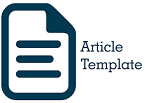ENGLISH TEXTBOOKS USED AT BANYUASIN SENIOR HIGH SCHOOLS: BASED ON CURRICULUM 2013
Abstract
Keywords
Full Text:
PDFReferences
Agrawal, M. (2004). Curricular reform in schools: the importance of Evaluation. Curriculum Studies, 36(3), 361–379.
Arikunto, S. (2010). Prosedur penelitian suatu pendekatan praktik. Jakarta: Rineka Cipta.
Cunningsworth, A. (1995). Choosing your course book. Oxford: Heinemann.
Dragana, M.G. (2011). Textbook: An Important element in the teaching process. Accessed fromepub.ff.uns.ac.rs/index.php/MV/a rticle/download/ 771/78.
Harmer, J. (1991). The practice of English language teaching. London: Longman.
Hutchinson, T., & Waters, A. (1987). English for Specific Purposes: A Learning-Centered Approach. Cambridge: Cambridge University Press.
Inderawati, Rita., Saputra, Hendri., & Vianty, Machdalena. (2017). A Content Analysis of Reading Texts’ Readability and Authenticity in the Textbook used by the Tenth Grade Students in Palembang. Unpublished Thesis of Graduate School FKIP Sriwijaya Palembang.
Juniawan, T, M. (2007). English textbooks used in senior high schools in Palembang: An evaluation referring to the 2004 English curriculum. Palembang: Sriwijaya University. Unpublished.
Litz, & David, R. A. (2002). Textbook evaluation and ELT management: A South Korean case study. ASIAN EFL Journal, 13(7):14. Retrieved from http://www.asian-efljournal.com/Litz_thesis.pdf.
Matthews, A. (1985). Choosing the best available textbook. In A. Matthews, M. Spratt, & L. Dangerfield (Eds.), At the Chalkface (pp.202-206). London: Edward Arnold.
Ministery of education and culture. (2013). Pemendikbud nomor 81a tahun 2013 tentang implementasi kurikulum. Jakarta.
Ministery of education and culture. (2013). Permendikbud nomor 71 year 2013. Jakarta: Kementerian Pendidikan Nasional Republik Indonesia.
Mukundan, J. (2011). Developing an English language textbook evaluation checklist. International Journal of Humanities and Social Science, 4(6), 100-106. Retrieved from http://www.ijhssnet.com/journa/Vol_1_No_12_September_2011/14.pdf.
Nimasari, P., E. (2016). Evaluating an EFL textbook: To what extent does the 2013 curriculum-based textbook accomplish pedagogical aspects?. Prosiding ICTTE FKIP UNS 2015. 1(1). Accessible in jurnal.fkip.uns.ac.id/index.php/ictte/article/viewFile /7630/5471.
OECD. (2015). The PISA 2000 assessment of reading, mathematical and scientific literacy. Retrieved from http://www.oecd.org/pisa/pisaproducts/drafts%20PISA%202015%20 Reading%20Framework%20.pdf/.
Richards, J. C. (2001). Curriculum development in language teaching. Cambridge: Cambridge University Press.
Richards, J. C. (2008). The role of textbook in a language program. Retrievedfromhttp://www.cambridge.org.br /site/articles.php?id=337.
Sheldon, L. (1988). Evaluating ELT textbooks and materials. ELT Journal, 42(4), 237-246. Accessible at citeseerx.ist.psu. du/viewdo/download?doi=10.1.1.473.7638&rep=rep1.
Tarigan, H. G. (1986). Telaah buku teks bahasa Indonesia. Bandung: Penerbit Angkasa.
Tomlinson, B. (2005). The future for ELT Material in Asia. Electronic
Journal of Foreign Language Teaching, 2(2):5-13. Accessed fromhttp://eflt.nus.edu.sg/v2n22005/tomlinson.html.
Walliman, N. (2011). Research methods: The basic. New York, NY: Routledge.
DOI: https://doi.org/10.32502/ecj.v2i1.1009
Refbacks
- There are currently no refbacks.
Copyright (c) 2018 English Community Journal
The Departement of English Education, Faculty of Teacher Training and Education, Universitas Muhammadiyah Palembang
Jl. Jenderal A. Yani 13 Ulu, Seberang Ulu II, Palembang (30263), Indonesia.
Indexed by :
English Community Journal has been listed in :

English Community Journal by http://jurnal.um-palembang.ac.id/index.php/englishcommunity is licensed under a Creative Commons Attribution-ShareAlike 4.0 International License.







